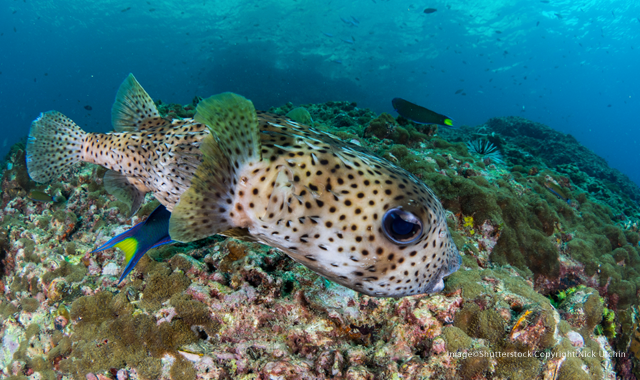Study finds human teeth evolved from same genes as pufferfish
Researchers discovered that pufferfish use the same stem cells for tooth regeneration as humans.

The topic of tooth regeneration in humans has been steadily growing in popularity.
For instance, researchers at Okayama University in Japan recently studied successful tooth regeneration in a postnatal large mammal. They found that the developmental process of a bioengineered tooth’s formation was practically identical to that of a natural tooth, and that the bioengineered tooth had the same structure and chemical composition of a natural one.
And in 2015, researchers at Georgia Institute of Technology King’s College in London studied hundreds of Lake Malawi cichlids, small fish that are native to Tanzania. The researchers discovered that, with the right stimulation, human epithelial tissue might be manipulated into regenerating new teeth.
Trending research: Extract of popular fruit could extend life of fillings
While all vertebrates have some sort of dental regeneration ability, humans lose the ability to regrow teeth after two generations. In an effort to better understand regenerative tooth capabilities and develop clinical applications in humans, researchers from the University of Sheffield in the United Kingdom, University of Tokyo in Japan and Natural History Museum in London examined embryos and scans of four species of pufferfish.
The team of researchers, which was led by Dr. Gareth Fraser from the Department of Animal and Plant Sciences at the University of Sheffield, discovered that the pufferfish beak is composed of four main units, one in each jaw quadrant. Each dental unit, which is band-like in shape, is created through the progressive accumulation of teeth. Pufferfish regenerate and replace their teeth within the dental cavity. Instead of losing teeth, multiple generations of teeth stack together within a compact mass, forming the beak. The oldest teeth are located at the top while the newest teeth develop at the base.
“We decided to study pufferfish beaks because they are some of the most novel and bizarre dentitions in the animal kingdom,” Fraser says via email. “As the name suggests, instead of making a 'normal' fish dentition with individual teeth, the pufferfish makes a unique beak-like dentition. The reason why this structure is so interesting to us is due to the way the beak forms via a modified form of dental regeneration. In most animals, including humans, first teeth are made and are replaced by similar teeth; however, in pufferfish the 'normal' first teeth are not all replaced and tooth replacement is restricted to the four front teeth.
“But the way these four teeth are replaced is odd compared to all other animals-it's even odd compared to other fish," Fraser continues. "Each tooth is replaced by elongated jaw length bands of enamel-like tissue and dentineand these structures are equivalent to a single replacement tooth in each jaw quadrant. The pufferfish produces multiple generations to these bands in each quadrant that stack together over developmental time to create the final form of the beak, necessary to crush hard prey items. The fact that these fish can regenerate their beaks continuously throughout life is one of the main reasons why we study fish.”
The results of the study showed that pufferfish use the same stem cells for tooth regeneration as humans do and that the pufferfish has a similar tooth-making process as other vertebrates, including humans. The pufferfish simply replace some of their teeth with the elongated bands that form their characteristic beak.
"Our findings were really exciting as we not only discovered how the pufferfish can make and regenerate its beak-like dentition, but we also identified the location of the stem cells that maintain the production of teeth that form the beak," Fraser says. "These stem cells are incredibly conserved among toothed animals, including humans, however in pufferfish they are maintained throughout life in the lips of the pufferfish, constantly activated for new teeth at the base of the beak. Our study showed that the pufferfish utilize the same highly conserved set of genes that we know are also important for tooth development and regeneration in all other toothed animals, including humans. This means that even the study of these weird fishes can help our understanding of general tooth development-and the study of these key stem cells for tooth regeneration can offer clues that may even help future human tooth therapies."
Fraser adds that further studies may uncover how dental stem cells can be maintained and activated throughout life for a continuous supply of teeth.
"Furthermore, this work will shed light on why these animals maintain their dental regenerative ability whereas other animals, e.g. humans, stop this process after a restricted number of tooth generations," he says. "We question whether the capacity for further regeneration can be achieved in animals with restricted tooth regeneration, so could we use this information to stimulate new tooth generations in animals where tooth production has ceased. Pufferfish may be able to help us get over this dental therapeutic hurdle."
Alex Thiery, a Ph.D. student at the University of Sheffield who contributed to the study, says, “I hope that our data encourage further dental developmental research in a wide range of vertebrate models, which will further our understanding as to how teeth are regenerated. In the future I hope this research, together with work in a range of other vertebrate models, can further our understanding as to how dental regeneration has been modified in vertebrates throughout evolutionary time, and ultimately why dental regenerative ability is lost in humans.”
The study, titled "Spatially restricted dental regeneration drives pufferfish beak development," first appeared in the scientific journal PNAS.
University of Texas Health Science Center San Antonio to Launch Center for Regenerative Sciences
June 17th 2024The center aims to translate preclinical discoveries into therapies for dental and craniofacial diseases, leveraging the school’s expertise in stem cell-based treatments and 3D printing technologies.